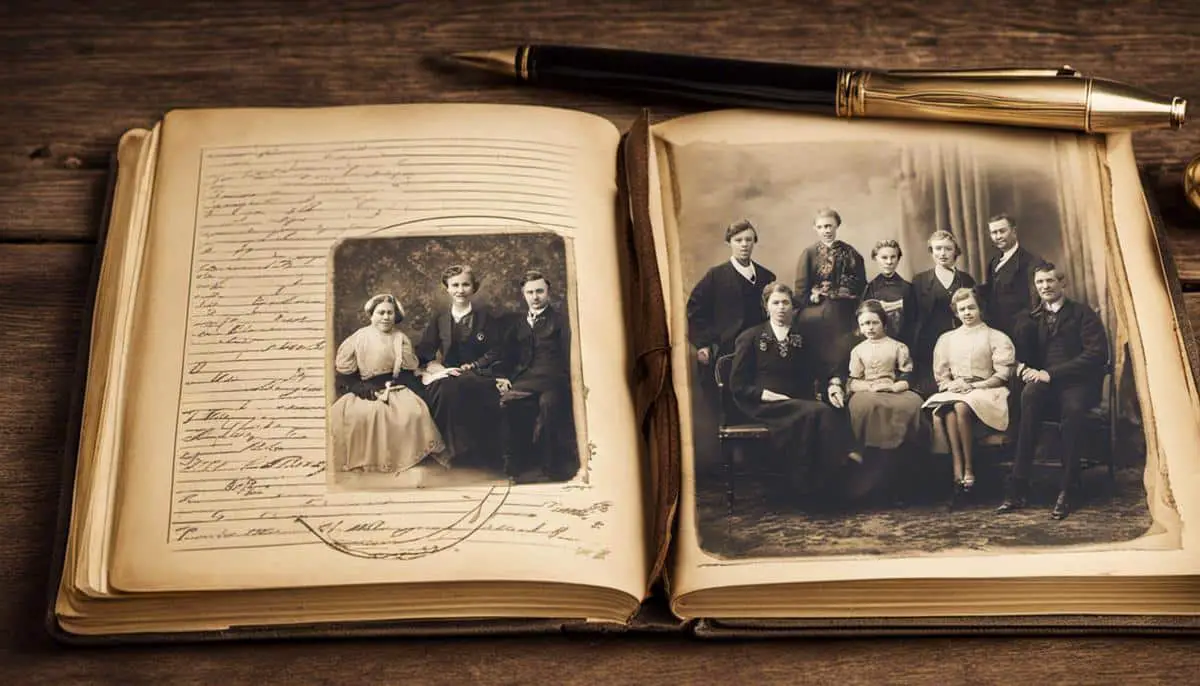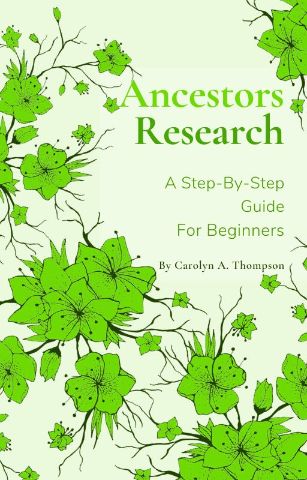Family History Blog: Embarking on the journey of tracing your family’s footsteps back in time is both a thrilling and enlightening venture. The world of genealogy goes beyond merely assembling names and dates.
It’s a path to self-discovery, allowing you to understand where you came from and the line of resilient ancestors who led to you.
Furthermore, constructing a family history blog grants you an outlet to share your unique stories, fostering a sense of community with your readers.
- Provide information on how to conduct family history research.
- Create an interesting family history blog and captivate your readers.
- Turning your website into a virtual gathering place for people who are interested in the historical period you represent.
🔍 Embark on a journey through time! Get started with our “Ancestors’ Research | Free Beginner’s Guide” [Dive In!]. ✨ Unlock essential tips and trace your heritage today!
Launching Your Family History Blog: A Starter Guide
Your Journey: A Starter Guide for Family History Blog Beginners
Imagine the magic of sitting down with loved ones, surrounded by generations of family photographs, birth records, newspaper clippings, or even old letters.
Unboxing the past and piecing together the beautiful puzzle of family history is an incredible journey to embark on.
Not only is it a wonderful way to bond and learn as a family, but it also instills a sense of pride and connection in the young ones about their roots.
Also, it nurtures identity and builds strength. The task might seem daunting, but let’s break this colossal mission into manageable steps to make the journey enjoyable.
Set Clear Goals:
- Before plunging into the depths of history, determining what is to be discovered is vital.
- Tracing migration patterns.
- Finding health information.
- Understanding cultural practices.
- Compiling a comprehensive genealogical record.
- Setting a specific focus will provide a clearer path to follow.
Start with What You Know and Broaden Out:
- The process begins at home.
- By compiling all the names and dates of births, marriages, and deaths in the immediate family.
- Expand the research outward from this solid foundation—grandparents, great-grandparents, and so on.
- Conversing with elder family members is a precious resource too.
- They’re likely to have facts and stories that won’t be found in any records.

Invest in Organizational Tools:
- Plan to invest both time and resources in gathering, preserving, and organizing all the data.
- A sturdy file or digital database is recommended for storing information, photos, and documents.
- Technology, like genealogical software, can make organizing and reviewing information simpler.

Embrace the Internet:
- Several online databases and websites are quite useful for family history research.
- Websites like Ancestry.com or MyHeritage.com offer access to millions of records worldwide.
- Furthermore, don’t overlook the power of social media like YouTube or Pinterest.
- Networking platforms can connect researchers with family members they didn’t even know they had.
Visit Public Libraries and Local Archives:
- Public repositories hoard a treasure trove of historical information that can aid in family history research.
- Census records, military records, land deeds, wills, and even local newspapers can be accessed for relevant details.
Consider DNA Testing:
- Today, relatively affordable DNA testing kits are available.
- They trace the tracks of ancestors across the globe and link researchers with others who share the same DNA.
- It’s like having a handy guide by your side that walks you through the untraveled terrain of your past.
Remember, patience and perseverance are just as crucial as these steps. It’s okay to encounter dead ends and uncertainties.
The aim isn’t to reach the finish line hastily but to enjoy the thrill of discoveries, shedding light on the lives that led to one’s own.
Indulge in the beautiful process of unearthing family history and let it draw the family closer, instilling a sense of treasured legacy. So go on, take the jump down this rewarding rabbit hole—you won’t regret it!
Cultivating Engagement on Your Family History Blog
Making Your Family History Blog a Two-Way Street: Engaging Readers and Fostering Participation
Building an engaging family history blog extends beyond merely unraveling your family’s past.
Also, it’s about weaving together a digital communal space that nurtures participation from a wide range of readers and contributors.
While the research process might be inherently personal, sharing it via a blog can be greatly enhanced through the active involvement of your readers.
Here’s how to nurture a family history blog that remains open, friendly, and inviting for its audience.
1. Ease of Interaction: Inviting Feedback and Discussion on Your Blog
Introducing user-friendly and accessible avenues for visitor input on your blog is crucial. Creating a unique ‘Contact Us’ form takes no time at all but can make all the difference.
Adding a comments section under each post or a forum page for discussions allows readers to ask questions, share their thoughts, or even their family stories. It’s about making your blog a hub of connection.
2. Leveraging Social Platforms: Enhancing Your Family History Blog’s Reach
By creating handles on popular social media platforms such as Facebook, Twitter, or Instagram, you not only widen the reach of your posts but also develop another platform for reader conversations and contributions.
Don’t restrict the sharing of family histories and narratives to your blog alone. Especially today, when social media networks are irreplaceable outlets for interaction, cross-platform sharing is highly beneficial.

Photo by invictar1997 on Unsplash
3. Engaging Through Surveys: Understanding Your Readers’ Interests
Surveys and polls are a fantastic way to kick-start reader participation.
This could range from asking readers for their favorite blog post to having them vote on the next research topic you should dive into.
VerticalResponse, SurveyMonkey, or even Google Forms can pave the way for fun and engaging polls.
4. Hosting Events: Bringing Your Blog’s Community Together
Online webinars, Facebook Live, and Zoom events can contribute to a communal spirit, with events such as “Family History Fridays” or “Ancestry Q&A sessions”.
This not only allows your readers to feel connected to you and other readers, but it also fosters community and encourages new readership through shared links and recommendations.
5. Guest Contributions: Enriching Your Blog with Diverse Family Stories
Inviting your readers to contribute their family histories via guest posts adds variety and depth to your blog.
The shared personal histories and different writing styles will ignite fresh reader interest.
A collective endeavor, the guest posts will turn your blog into a communal assemblage of family histories instead of one family’s journey.
6. Incorporate User-Generated Content:
Consider using a hashtag specific to your blog and encouraging your readers to share their related photos, documents, or even quick-written snippets on social media.
User-generated content can prove a refreshing, engaging feature that simultaneously builds community spirit.
7. Keep the Conversation Alive:
Remember to reply to comments, thank readers for sharing your posts, and appreciate the effort of guest contributors.
Authentically interacting, acknowledging, and responding can create an atmosphere of mutual respect, convincing readers that their participation is not just welcome but significantly valuable.

Why Monetize Your Family History Blog?
Turning Passion into Profit with Your Family History Blog
Monetizing your family history blog is a strategic way of transforming your dedication to genealogy into a sustainable practice.
By directing revenue towards your research and blog quality, you can offer your audience a more enriched experience.
Enhanced funding means you can access expansive archives and state-of-the-art genealogical tools, ensuring that every post on your family history blog is as informative and engaging as possible.
This approach not only furthers your personal journey but also solidifies your blog’s standing as a premier destination for genealogy enthusiasts, potentially turning your passion project into a profitable venture.
Sustaining Your Family History Blog
Maintaining a family history blog comes with its share of costs—domain fees, hosting services like GoDaddy, and research tools all add up.
Monetization is not just beneficial; it’s essential for the longevity and quality of your site
By leveraging methods such as affiliate marketing, sponsored content, and exclusive memberships, you can offset these expenses.
This fiscal support is critical, allowing you to continuously offer a treasure trove of family history insights without compromising on the depth and quality that your readers have come to expect.
Community Support for Your Family History Blog
In the era of community-supported initiatives, readers of your family history blog may be inclined to support the content they have grown to love.
By monetizing your blog, you are giving your community a chance to contribute to the preservation and growth of the historical narratives you share.
It’s an invitation for them to become stakeholders in a collective memory project, ensuring that the stories that have captivated them continue to flourish.
Through donations, subscriptions, or merchandise, your audience can actively participate in the celebration and exploration of shared heritage, securing the blog’s future as a valuable family history resource.

Monetizing Your Family History Blog: A Strategic Approach
Embarking on Affiliate Marketing
Dive into the world of affiliate marketing to monetize your family history blog. Forge alliances with leading genealogy sites, DNA testing facilities, and archival resources.
Seamlessly weave affiliate links into your blog posts that align with your research, guiding your dedicated readers to invaluable tools and services that aid their ancestral quests.
Sponsored Content Creation
In your family history blog, create rich, sponsored content by partnering with distinguished brands that resonate within the genealogy and preservation community.
This sponsorship not only offers financial backing for your endeavors but also enriches the blog’s content, cementing your status as a trusted voice in the family history sphere.
Membership Access and Exclusives
Enhance your family history blog by introducing a membership model.
Offer exclusive access to specialized content like deep-dive webinars or tailored research guidance, transforming your audience into a tight-knit community.
Utilize platforms like Patreon to manage these memberships, further enriching the blog’s value and fostering lasting engagement.
Digital Products and Genealogical Guidance
Utilize your family history blog as a platform to market digital products—e-books, bespoke research templates, or intricate family tree designs.

Develop and sell educational content, such as webinars or online courses, that provides thorough insights into genealogical research techniques.
Donation-Driven Community Support
Incorporate a donation option on your family history blog through services like PayPal or Ko-fi, inviting your audience to financially support the blog’s growth and your ongoing research.
Transparency about how donations enhance the blog can foster a stronger connection and a sense of community participation.
Ad Revenue and Experience Equilibrium
On your family history blog, strategically place display ads through networks like Google AdSense.
This strategy can be a significant revenue source, provided you maintain a harmonious balance between ad presence and a positive user experience, ensuring that the blog remains reader-friendly.

Consultation and Custom Writing Services
Leverage your expertise in family history by offering personalized writing and research consultation services.
Detail these offerings on a ‘Hire Me’ section of your family history blog, showcasing your capabilities and successful projects, thus attracting clients seeking specialized genealogical services.
Workshops and Speaking Opportunities
Capitalize on speaking engagements and workshops to share your knowledge and passion for family history research.
Your family history blog can serve as a launching pad for these paid events, allowing you to engage with your audience on a more personal level and share valuable research techniques.
Incorporating these monetization strategies effectively, with a careful eye on SEO practices, ensures that your family history blog doesn’t just thrive as a repository of ancestral stories.
But also as a sustainable venture that connects past, present, and future genealogy enthusiasts.
The Building Blocks of a Family History Blog
Are you ready to channel your passion for family history into a captivating blog that not only tells your unique ancestral story but could also turn into a profitable venture?
Whether you’re starting from scratch or looking to enhance your existing site, we’ve got you covered!
🌟 Dive into our comprehensive post where we break down the essentials:
- How to Create Your Own Blog: 15 Best Tips: Step into the digital world with ease. Our guide simplifies the technicalities, making it accessible for everyone, regardless of tech expertise.
- How To Turn Your Hobby into a Business | Best Tips: offers essential strategies for transforming your passion into a profitable venture, covering everything from market research to branding for aspiring entrepreneurs.
- How to Decipher The Meaning of Family Relationships: provides insightful guidance on understanding and navigating the complex dynamics of family ties. This article explores the significance of various family roles and connections, offering valuable perspectives for deeper familial understanding and harmony.
💡 Take the first step towards creating a blog that’s both fulfilling and financially sustainable.
Conclusion
Running a family history blog is about fostering a vibrant conversation—a dynamic exchange that starts with your ancestors’ stories and expands with contributions from a global audience.
Engaging your readers transforms them into active participants who not only add to the narrative but also amplify it through sharing.
As your community flourishes, the shared tapestry of stories on your blog becomes even more colorful and detailed.
Picture a diverse group huddled around a laptop, emblematic of the inclusive and spirited community that a family history blog nurtures.
Within the digital universe, your family history blog emerges as a welcoming lighthouse, attracting those eager to delve into their heritage.
By combining thorough research, strategic reader interaction, and a well-crafted blog platform, your site can evolve into a treasured gathering place for you and your audience
Bring your family tree to life on your blog and illustrate the irreplaceable treasure of family history, forging a legacy that will echo through the ages.
Frequently Asked Questions (FAQ)
- What is a family history blog?
- A family history blog is a personal online space where individuals share their journey of discovering their ancestry. It includes stories, research tips, genealogical findings, and more, offering a unique blend of personal narrative and historical documentation.
- How do I start my own family history blog?
- Starting a family history blog involves choosing a blogging platform, registering a domain name, designing your blog, and creating content. It’s important to have a clear focus, whether it’s sharing your family’s stories, offering research advice, or connecting with others interested in genealogy.
- Can I make money from my family history blog?
- Yes, you can monetize your family history blog through various methods such as affiliate marketing, sponsored posts, memberships for exclusive content, selling digital products, accepting donations, and offering paid services such as writing or genealogical research.
- What are some tips for engaging readers on my family history blog?
- Engage readers by encouraging interaction through comments, incorporating user-generated content, leveraging social media, conducting reader surveys, and hosting interactive events. It’s also effective to invite guest posts and regularly update your blog with fresh and intriguing content.
- Where can I find resources for my genealogical research?
- Resources for genealogical research can be found in online databases, at local libraries and archives, through DNA testing, and on various genealogy-focused websites and forums. Networking with other genealogy enthusiasts and professionals can also provide valuable insights and guidance.







